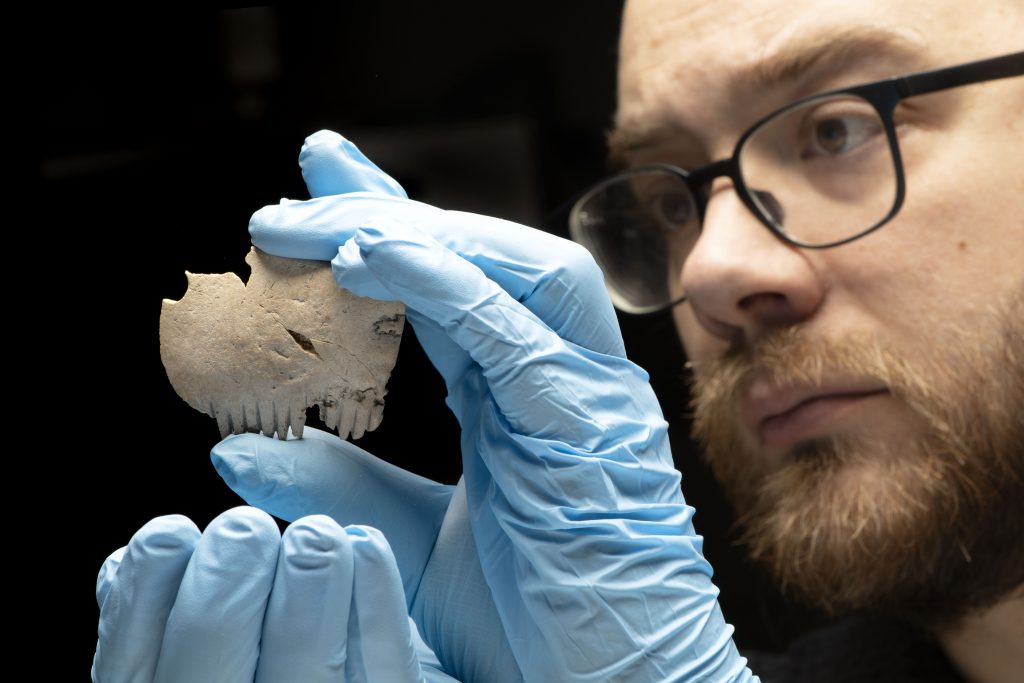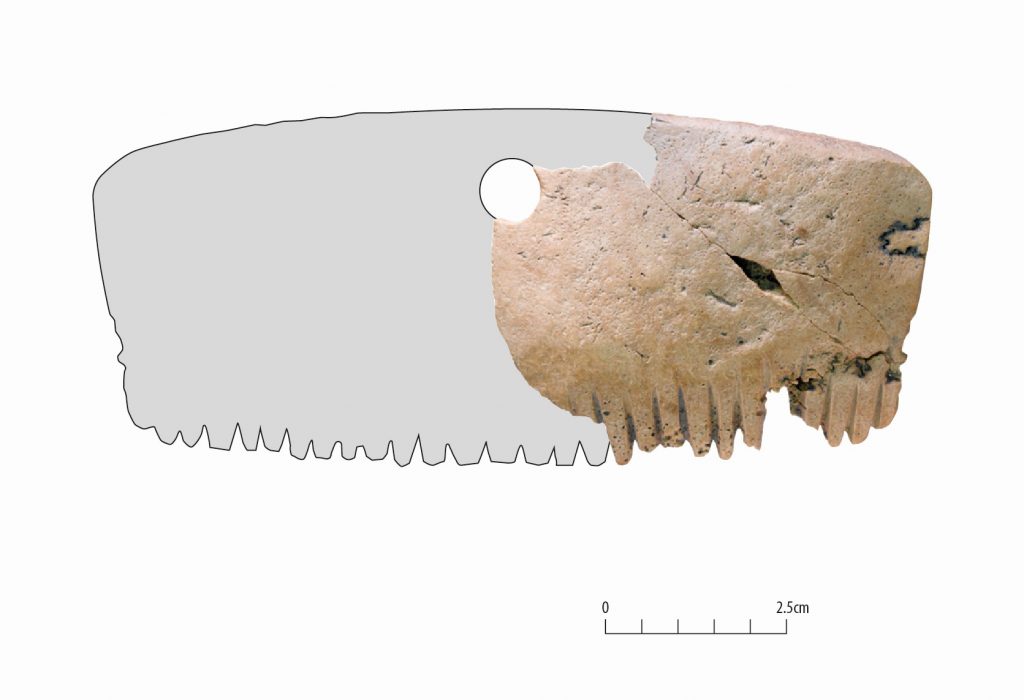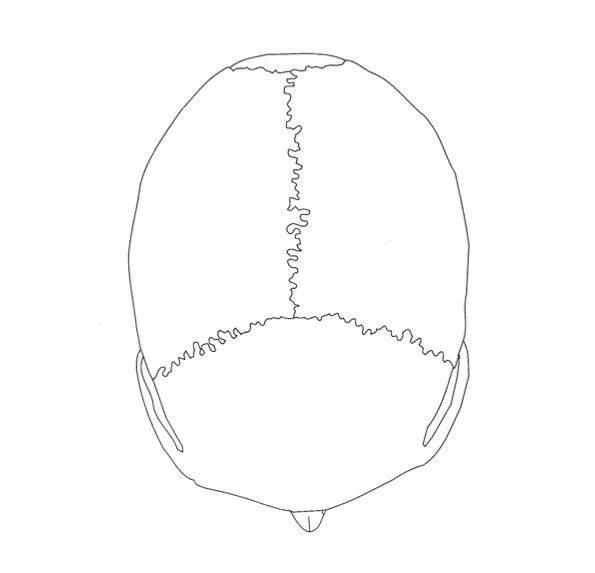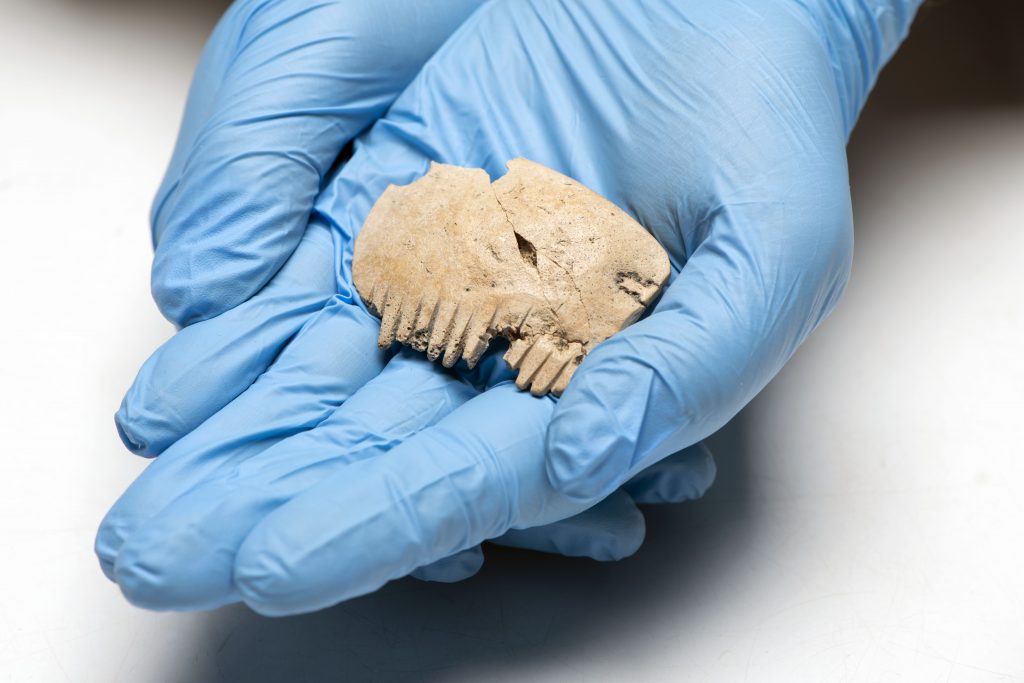Warning: this blog post contains images and discussion of human remains.
When archaeologists working on the National Highways A14 Cambridge to Huntingdon scheme discovered a fragment of a comb, they knew they had found something unusual. But it took months of research by MOLA’s Finds Specialist, Michael Marshall, and Osteology Team to show just how extraordinary this find was…

MOLA Finds Specialist Michael Marshall with the Bar Hill Comb © MOLA
The comb was found at Bar Hill near Cambridge, a site which has already offered up its share of mysterious finds – including more than 8000 frog bones from a ditch at the Iron Age settlement.
The comb dates to the Iron Age (750 BC – 43 AD). It is rectangular, with rounded edges and coarsely cut teeth. All in all, a fairly standard Iron Age bone comb. However, further study revealed something very unusual about this particular comb – it is carved from part of a human skull.

Graphic showing area of the skull used to make the Bar Hill Comb © MOLA
It might be surprising, but in Iron Age Britain people used human bone to make lots of different tools. Other excavations in Cambridgeshire have uncovered tools for cleaning animal skins made from human leg and arm bones. The Bar Hill comb could have been a used for textile work or even combing hair. However, Finds Specialist, Michael, quickly spotted something which blew this theory right out of the water -there was no wear on the comb’s teeth. This means it was probably never used as a comb.
Archaeological evidence from across Europe tells us that the human head was really important to Iron Age people. They were treated differently to other human bones. Across the continent, including Britain, skulls were collected and even displayed at the entrances to settlements. This may have taken place during times of conflict as “headhunting trophies”.1 There are also examples from Britain of pieces of human skull with holes drilled into them. These may have been worn as amulets.
The Bar Hill comb had a circular hole drilled into it. This means it could have been worn as an amulet.

Reconstruction of the Bar Hill Comb © MOLA
Although amulets made from human skull were common in Iron Age Britain, the Bar Hill comb still stands out. In fact, it is one of only three Iron Age combs made from human skull ever found. And the other two come from just down the road. The first was found at excavations at Earith, 9 miles north of Bar Hill, in the 1970s. The second, which has carved lines rather than teeth, was found during excavations at Harston Mill, 10 miles south of Bar Hill in the early 2000s. This suggests it may have been an Iron Age tradition unique to this part of Britain!
Conversations between Michael Marshall and MOLA Osteologist (human bone expert), Michael Henderson, also sparked a new theory. It is possible the teeth of the comb could represent the natural sutures that join sections of the human skull.

Illustration showing skull sutures © MOLA
Michael Marshall explains further:
“These carved teeth and lines would have highlighted the Bar Hill Comb’s origin, especially for local Iron Age communities who were familiar with skeletal remains. It’s symbolism and significance would have been obvious to anyone who encountered it.”
Instead of being just a practical tool, the Bar Hill comb may have been a powerful object for members of the local Iron Age community. Perhaps the skull belonged to an important person, who continued to play a role in the community even after their death.

The Bar Hill Comb © MOLA
More of these combs may be revealed by future excavations across Cambridgeshire, but for now many questions remain. We don’t have any written evidence from people living in Iron Age Cambridgeshire, so we will never know exactly why this was made. We can only imagine the thoughts or feelings the amulet would have inspired in the people who held or wore it.
Join us on our journey!
#A14Archaeology
Find out more about the A14C2H improvement scheme
The archaeological programme for the Cambridge to Huntingdon National Highways scheme is being carried out by A14 Integrated Delivery Team on behalf of National Highways.
0 Comments
Leave A Comment